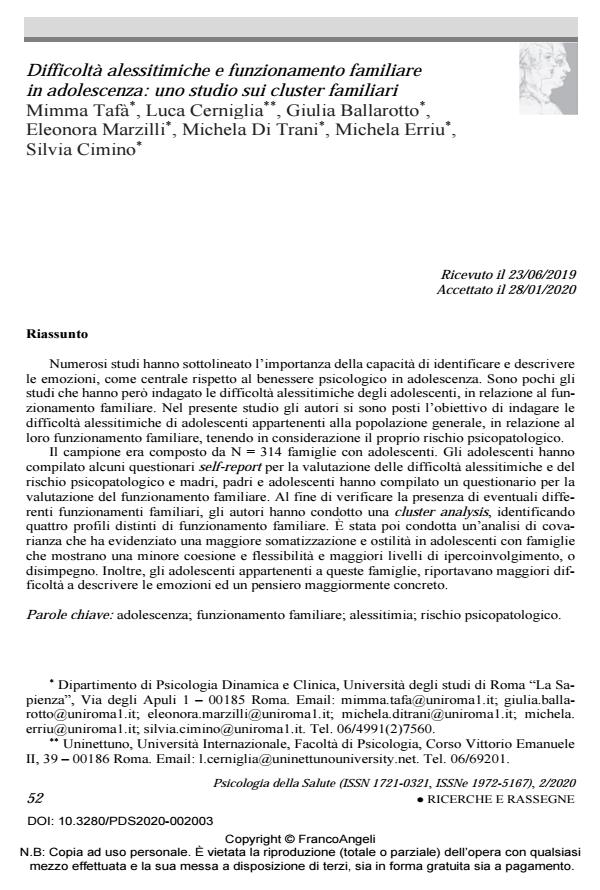Alexithymia and family functioning in adolescence: a study on family clusters
Journal title PSICOLOGIA DELLA SALUTE
Author/s Mimma Tafà, Luca Cerniglia, Giulia Ballarotto, Eleonora Marzilli, Michela Di Trani, Michela Erriu, Silvia Cimino
Publishing Year 2020 Issue 2020/2
Language Italian Pages 19 P. 52-70 File size 286 KB
DOI 10.3280/PDS2020-002003
DOI is like a bar code for intellectual property: to have more infomation
click here
Below, you can see the article first page
If you want to buy this article in PDF format, you can do it, following the instructions to buy download credits

FrancoAngeli is member of Publishers International Linking Association, Inc (PILA), a not-for-profit association which run the CrossRef service enabling links to and from online scholarly content.
Several studies have stressed the importance of the ability to identify and describe emo-tions to psychological well-being in adolescence. However, fewer studies have investigated adolescents’ alexithymic difficulties in relation to family functioning. The aim of this study was to investigate the alexithymic difficulties of adolescents belonging to the general popula-tion, in relation to their family functioning, taking into account their psychopathological risk. The sample was composed of N = 314 families with adolescents. Adolescents filled out some self-report questionnaires for the evaluation of alexithymic difficulties and psychopathological risk and mothers, fathers and adolescents filled out a questionnaire for the evaluation of family functioning. In order to verify the presence of different family functioning, authors have con-ducted a cluster analysis, which identified four distinct profiles of family functioning. Then, covariance analysis was conducted, which showed greater somatization and hostility in ado-lescents with families that show less cohesion and flexibility and greater levels of enmeshment or disengagement. Moreover, adolescents belonging to these families reported more difficul-ties in describing emotions and more concrete thinking.
Keywords: Adolescence; family functioning; alexithymia; psychopathological risk.
Mimma Tafà, Luca Cerniglia, Giulia Ballarotto, Eleonora Marzilli, Michela Di Trani, Michela Erriu, Silvia Cimino, Difficoltà alessitimiche e funzionamento familiare in adolescenza: uno studio sui cluster familiari in "PSICOLOGIA DELLA SALUTE" 2/2020, pp 52-70, DOI: 10.3280/PDS2020-002003